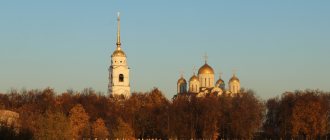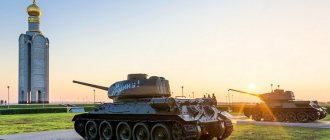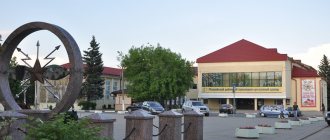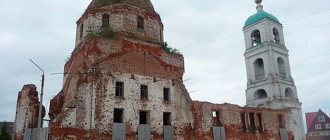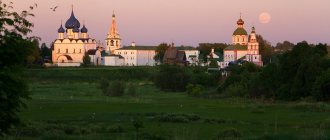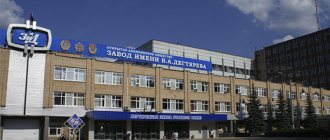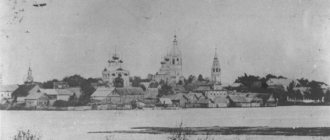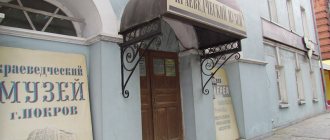Vladimir
History of the city of Vladimir
The Vladimir lands have been inhabited by people since Paleolithic times. This is evidenced by stone tools found during archaeological excavations. In the 6th-7th centuries, the ancient chronicled Merya tribe lived in the surrounding forests, and on the hill where the majestic Assumption Cathedral now stands, researchers discovered a Meryan village.
Prince Vladimir I Svyatoslavovich
In the 9th-10th centuries, the Krivichi Slavs began to settle on the banks of the Klyazma. Most historians believe that the city appeared in 1108, and the Novgorod Chronicle names the name of its founder - the Russian prince Vladimir Vsevolodovich Monomakh. Some local historians are confident that Vladimir appeared earlier - in 990, thanks to Prince Vladimir I Svyatoslavich, under whom the baptism of Rus' took place. It is interesting that the version about an earlier dating of the city’s foundation was also supported by the famous Russian philologist Dmitry Sergeevich Likhachev.
Vladimir quickly grew and strengthened as a stronghold for the defense of the surrounding lands. In 1157, the prince made it the capital of the Rostov-Suzdal principality. It is known that Vladimir was raided several times by Tatar troops, with the most devastating attacks occurring in 1238 and 1293. In 1382, like other Russian settlements, the city suffered greatly from the troops of Tokhtamysh.
Vladimir was the main city in North-Eastern Rus'. He did not have his own princely dynasty, so the city was ruled by appanage princes appointed by the Horde.
After the rise of Moscow, Vladimir became a provincial town. A slight cultural and economic recovery began only in the second half of the 18th century, when the city was made the center of the governorship, and then the center of the province. In Vladimir, stone public buildings began to be built, several educational institutions, a drama theater, a printing house and a museum were created. Big changes were brought by the opening of the railway that connected Vladimir with Moscow.
Vladimir on postcards of the early 20th century
After the establishment of Soviet power, some city streets were renamed, and most parish churches were closed to believers. A little later, 6 churches and the Cathedral of the Nativity Monastery were demolished. In pre-war times, Vladimir grew rapidly and began to turn into a large industrial center.
During the Great Patriotic War, many residents from the western regions of the country were evacuated here. There were 18 hospitals in the city, and residents of Vladimir actively donated blood for the wounded.
In the post-war years, the industrialization of the city continued. In 1960, a bridge was built across the Klyazma and a residential area was erected on the right bank of the river. Since the 1970s, Vladimir has become one of the tourist centers. Today, many travelers from other cities of the country and from abroad come here to get acquainted with the history of Vladimir and see ancient historical monuments.
View of the city from the bridge over the Klyazma
Sights of Vladimir
The ancient Russian city of Vladimir is famous for its rich, centuries-old history and unique architecture. First of all, tourists tend to visit sites on the UNESCO World Heritage List.
Golden Gate
In the 12th century, Vladimir was surrounded by a rampart and had five entrance gates. Only one of them has survived to this day - the Golden ones. A unique monument of ancient Russian serf architecture is located in the historical center, on Bolshaya Moskovskaya Street, 43. The Golden Gate served as the main entrance to the city. The prince and his squad traditionally passed through them to Vladimir.
Today, inside the ancient fortress gates there is a museum of military valor. Its exhibitions are located in the gate temple. Tourists who come here can see ancient armor and weapons. Stands and display cases tell about the military feats of famous Russian commanders, and in the center of the museum there is a diorama depicting the siege of Vladimir in 1238. From Monday to Thursday the museum is open from 10.00 to 16.00. On other days it closes an hour later. The exhibition is closed on Tuesdays.
Golden Gate from Bolshaya Moskovskaya Street
View of the Golden Gate from Kozlov Val
Passage under the Golden Gate
Assumption Cathedral
The ancient Orthodox church has stood on the high bank of the Klyazma for more than 850 years. It was founded in 1158, during the reign of Andrei Bogolyubsky. The prince wanted the new temple to become the main one in all of Vladimir-Suzdal Rus', so he called the best masons, icon painters and jewelers to build it. Famous masters came to Vladimir from Kyiv, Galich, Germany and Greece.
The five-domed cathedral still remains one of the main decorations of the city. It is the tomb of Vladimir bishops and metropolitans. Inside the ancient temple you can see preserved fragments of wall paintings made by the famous Russian isographer Andrei Rublev.
Assumption Cathedral
Stone carvings on the walls of the Assumption Cathedral
Dmitrovsky Cathedral
The austere and majestic Dmitrovsky Cathedral was built later than the Assumption Cathedral - at the end of the 12th century, when Vsevolod the Big Nest reigned. The prince wanted his “personal” temple to appear in Vladimir, and at the request of the ruler, the collection was consecrated in honor of Dmitry of Thessalonica, revered by Christians.
Dmitrovsky Cathedral is a Byzantine four-pillar temple with three semicircular altar apses. It is richly decorated with elegant white stone carvings, and is often called a “poem in stone” for its beauty. Judging by the external decoration of the cathedral, we can conclude that not only Vladimir, but also Greek carvers worked on it.
The inside of the temple looks much more modest. Among the ancient frescoes, a wall painting from the 12th century, made by a Greek isographer and his Russian assistant, has been preserved.
Dmitrovsky Cathedral
Decor of the dome of Dmitrovsky Cathedral
Stone carvings on the walls of Dmitrov Cathedral
Assumption Cathedral in Vladimir
The Assumption Cathedral is a unique monument of white stone architecture of the pre-Mongol era. It was built in...
Golden Gate in Vladimir
The Golden Gate of Vladimir is a monument to ancient Russian fortification, built in 1158-1164...
Demetrius Cathedral in Vladimir
Demetrius Cathedral was built in the name of St. Demetrius of Thessalonica by Prince Vsevolod Yuryevich Bolsho...
All sights of Vladimir
Museums of Vladimir
Not far from the Assumption and Dmitrovsky Cathedrals there is a large museum complex “Chambers”. It occupies three floors of a building built in the 18th century (Bolshaya Moskovskaya Street, 58). The museum complex consists of permanent displays and exhibitions for adults and children, which introduce guests to the structure of the Russian home, the traditions of the old school, folk fairs and book printing. The “Chambers” also has an art gallery, where more than 300 paintings by artists of the 18th-20th centuries are collected. Immersion in the past begins right from the door, as all the guides and staff of the museum complex greet visitors in 19th-century costumes. The museum complex is open every day except Monday: on Tuesdays and Wednesdays from 10.00 to 16.00, and from Thursday to Sunday from 10.00 to 17.00.
In the museum complex "Chambers"
One of the city’s museums is called “Old Vladimir”. It is very easy to find because the building it occupies looks like a stylized fortress (Kozlov Val Street, 14). It's actually a converted water tower. The museum is dedicated to the history of the city of the late 19th – early 20th centuries. Here you can see what a typical Vladimir tavern and church shop, horse-drawn carriage and officer's house looked like. The walls of the halls are hung with old photographs, clippings from city newspapers and theater posters. Tourists love “Old Vladimir” for the observation deck at the top of the tower, which offers a good panorama of the city and the spacious valley of the Klyazma River. The museum is open daily, except Mondays, from 10.00 to 18.00.
The building of the museum "Old Vladimir"In one of the halls of the museum "Old Vladimir"
The land of Vladimir, rich in talent, has long been famous for its folk crafts, so since the mid-1970s, a museum of crystal, lacquer miniatures and embroidery has been opened in the Old Believer Trinity Church. It is located next to the Golden Gate, on Dvoryanskaya Street, 2. On the ground floor of the museum, objects of decorative and applied art are exhibited - glass and crystal items, as well as lacquer miniatures from the Vladimir village of Mstera. On the second floor, folk embroideries are exhibited - the famous “Mstera smooth surface” and “Vladimir seam”. The museum is open to guests from Tuesday to Sunday from 10.00 to 18.00.
To find out the most interesting details from the 1000-year history of Vladimir, many travelers go to the old building located between the Mother of God Nativity Monastery and the green Lipki Park (Bolshaya Moskovskaya St., 64). The historical museum occupies a mansion built in 1900. A rich archaeological collection from the primitive site of Sungir is kept here. In the halls of the museum you can see rare photographs and documents, ancient coins and weapons, ancient books, and household items used by the residents of Vladimir. On Monday and Thursday the museum is open from 10.00 to 16.00, and on other days until 17.00. Day off is Tuesday.
Museum of Crystal, Lacquer Miniatures and Embroidery
Historical Museum
The building attached to a two-story merchant estate of the 19th century houses the Stoletovs' house-museum. Representatives of this family left a big mark on the history of Vladimir. Members of the Stoletov family were eminent merchants, generals and scientists. The museum is open to visitors on Tuesday, Friday, Saturday and Sunday from 10.00 to 16.30, on Wednesday and Thursday from 10.00 to 15.30. It is located opposite the Mother of God Nativity Monastery, on Stoletov Street, 3.
To learn more about the nature of the Vladimir region, it is worth planning a visit to the Native Nature Museum, which is located on Mira Street, 19, not far from the Vladimir administration building. The museum halls display stuffed animals living in the local forests. Here you can see wolves, bears, deer, wild boars, elk and lynx. It is interesting to look at the typical natural corners of Central Russia modeled in the halls - meadow, field, pond and forest. It is noteworthy that the visual exhibitions are complemented by the sounds of nature - birdsong, animal cries and the buzzing of insects. You can get to the museum from Tuesday to Friday from 10.00 to 17.00, and on Saturdays and Sundays from 10.00 to 16.00.
Those who are partial to Russian pastries should go to Bolshaya Moskovskaya Street, 40, where the Vladimir Gingerbread Museum is located. The private collection is housed in a building erected at the end of the 18th century and tells about the traditions of making Russian gingerbread. Master classes are held for museum guests, during which everyone can try to paint a printed gingerbread. Here, in the store they sell delicious souvenirs. The museum is open seven days a week: on weekdays from 9.00 to 19.00, and on Saturdays and Sundays from 10.00 to 20.00.
Stoletov House-MuseumIn the “Native Nature” Museum
Vladimir Gingerbread Museum
The active development of tourism was one of the reasons for the appearance of another private museum dedicated to spoons in Vladimir. It is located opposite the Northern Trade Rows, at number 4 on Oktyabrskaya Street. In the museum display cases you can see the products of spoon makers who made spoons for the court of the Russian emperors, spoons as gifts, as well as spoons that were used for church ceremonies. The museum's collection contains not only Russian spoons - many souvenirs brought from other countries are exhibited here. The museum doors are open from 11.00 to 19.00 on any day except Monday.
Spoon Museum
Spoon Museum
In Vladimir there is an open-air museum dedicated to railway transport. Near Vokzalnaya Square, passenger and freight cars for narrow-gauge railways are displayed, and next to them stands a steam locomotive of the L series, produced in the middle of the last century.
In the historical center, on Bolshaya Moskovskaya Street, 26, an interactive fairy tale museum “Babusya-Yagusya” is open for children. About a hundred images of one of the main heroines of folk tales, Baba Yaga, are stored here. On the shelves of the museum are paper and clay fairy-tale “old ladies”, as well as figurines made of metal, wood and wax. To prevent children from getting bored, they are accompanied by actors dressed in costumes of Kikimora and Koshchei the Immortal. The fairy tale museum welcomes guests every day from 10.00 to 22.00.
At the Babusya-Yagusya Museum
Where to eat
In Vladimir, and especially in the historical center of the city, there are many restaurants and cafes. Most of them are located on Bolshaya Moskovskaya and adjacent streets. It serves traditional Russian cuisine, as well as dishes from European, Mediterranean, Italian, Japanese and Caucasian cuisines. Pancakes are very popular among tourists; they can be ordered in any cafe in Vladimir.
Tasty and inexpensive food is served in the fast food cafe of the Globus hypermarket, which is located at the exit from the city towards Suzdal (Suzdalsky Ave., 28). This cafe is open from 8.30 to 23.00 from Monday to Thursday and from 8.30 to 24.00 from Friday to Sunday.
At the exit from Vladimir towards Yuryev-Polsky there is a shopping mall (Traktornaya St., 45). On the second floor of the building there is a good budget food court. You can have a good and inexpensive lunch in the “Silver Horseshoe” dining room, which is located on the second floor of the shopping center. It is open from 9.00 to 18.00.
Cafe "Abazhur"Bar "Zhiga-Bar"
Souvenirs
Travelers who want to buy souvenirs in Vladimir can do this in small shops on Bolshaya Moskovskaya Street, in specialized stores, museums, as well as in the souvenir departments of large shopping centers. Images of the coat of arms of Vladimir, the Golden Gate, the Assumption and Dmitrov Cathedrals are very popular among tourists. The city sells mugs, plates, keychains and other products with popular views of Vladimir.
Souvenir shops sell busts of famous Vladimir residents who left a big mark on the history of the ancient Russian city, wickerwork and painted ceramic dishes. Popular souvenirs are painted wooden jewelry and birch bark products.
There is a small factory in the city that produces silverware, so in Vladimir’s stores you can always see cutlery sets of spoons, knives and forks, decorative spoons with the inscription “Vladimir”, elegant culinary spatulas, silver coasters for cups and neat napkin rings.
One of the ancient local crafts is embroidery. Beautiful products with colored “Vladimir seam” and Mstera white satin stitch are sold not only in souvenir shops, but also in large department stores. These are bed linen sets, pillowcases, napkins, towels and clothing items.
Among the “delicious” souvenirs from Vladimir are fragrant Pokrovsk gingerbreads, chocolate and chocolate candies. If your trip occurs in the summer, it’s worth looking for the famous Vladimir cherry tree. Local gardeners grow berries of excellent quality, which are distinguished by their juiciness, dark color and slight sourness.
At the souvenir shop
Souvenir ceramics
Souvenirs at the Gingerbread Museum
Transport
The historic city center is quite compact and easy to get around on foot. In Vladimir there are 8 trolleybus routes and 30 bus and minibus routes. Public transport starts running around the city from 5.30 am. On those routes on which, in addition to the number, the letter “C” is indicated, large-capacity buses travel, intended for preferential travel on a single social travel card.
Suburban buses connect Vladimir with other cities and villages in the region. By buses No. 3C, 18C, 53, 102, 107 and 152 you can get to Bogolyubov, near which is the famous Church of the Intercession on the Nerl.
If you wish, you can always take a taxi in Vladimir by stopping the car on the street or ordering it by phone. Competition among drivers is high, so when a taxi is called, it arrives very quickly.
Accommodation
Vladimir is aimed at tourists, so many hotels of different levels have been built in the city - from luxury hotels to inexpensive hostels. Conveniently, full information about options for where to stay and prices can always be obtained from the information desk at the railway station or from any of the travel agencies in Vladimir. You can also book a hotel room in advance using the Booking.com service, which will be especially important during the height of the tourist season.
Hotel "Vladimir"Hotel "Vladimir"
Several hostels offering accommodation from 400-500 rubles per night are located in close proximity to the train station. In addition to hostels, Vladimir guest houses, recreation centers and tourist centers offer budget rooms. Those who travel with the whole family or in the company of friends prefer to rent apartments for daily rent in Vladimir.
Booking.com
How to get there
Vladimir is located 190 km east of Moscow. There are different ways to get to this city. The journey by car takes about 3.5-4 hours. Motorists should take into account that the section of the M-7 Volga highway from the capital to Balashikha is almost always “stopped”, and instead of 25-30 minutes it takes about an hour to overcome it.
A simple and economical option is to get to Vladimir by train. Every day, more than a dozen electric trains and long-distance trains depart from Kursky Station in the desired direction. Some of them are direct, and some go to Nizhny Novgorod and make an intermediate stop in Vladimir. The journey takes from 1 hour 39 minutes to 3 hours 35 minutes. The fastest trains are “Lastochka” and “Strizh”. Conveniently, the railway station in Vladimir is located near the historical center of the city.
Some people prefer to come to Vladimir by buses that depart from the bus station near the Shchelkovskaya metro station. Regular buses start running from 6.00. Depending on traffic, the journey by bus takes from 3 to 5 hours. Regular buses also run to Vladimir from Yaroslavl, Ivanovo, Murom, Gorokhovets, Pereslavl-Zalessky, Alexandrov and some other Russian cities.
Capital of the principality
In 1157, after the death of Yuri Dolgorukov, his son Andrei Bogolyubsky became the Prince of Vladimir-Suzdal and moved the capital of North-Eastern Rus' to Vladimir.
Under Prince Andrei Bogolyubsky, the white-stone Assumption Cathedral was erected in 1158–1160.
Vladimir was being built up, and the so-called New City appeared in its western part. To protect it, Prince Andrei erected additional defensive structures. The new city was fenced with fortifications in the form of ramparts about 9 meters high, on which wooden walls and four gate towers were built. The wooden towers were called “Volzhsky”, “Irininy” and “Copper”.
For the main entrance to the ancient city from the west, from Moscow, the ceremonial white stone Golden Gate with the gate church of the Deposition of the Robes of the Blessed Virgin Mary was erected. To enter Vladimir from the east, at the bridge over the Lybid River, on the road to Nizhny Novgorod, Suzdal and the princely castle in Bogolyubovo, the Silver Gate was installed. The path to the craft settlements led through the Copper Gate. Yes, only the Golden Gate has survived to this day.
Golden Gate
The Golden Gate was distinguished by its height, slender proportions and rich decoration. The huge oak gate leaves were covered with gilded bronze sheets, thanks to which the gate got its name. The wooden walls of the New City fortress adjoined the gate.
According to legend, Prince Andrei, who sincerely loved the city, wanted to please the townspeople and open the Golden Gate on the feast of the Dormition of the Blessed Virgin Mary. The builders did not wait for the building to shrink and immediately after the completion of the masonry they hung the gate. As a result, the doors fell and crushed 12 citizens.
Then the prince turned to the Queen of Heaven with a prayer, asking her to save the victims: “If You do not save these people, I, a sinner, will be guilty of their death.” Andrei's prayer was heard and a miracle happened: when the gates were raised, it turned out that all the people crushed by them remained alive and unharmed.
After the murder of Andrei Bogolyubsky in 1174, the grand-ducal table was taken by his younger brother Vsevolod the Big Nest, who was also called Vsevolod III.
More about the Golden Gate >>
Capture of the city by the Mongol-Tatars
In the winter of 1237–1238, the Mongol-Tatars began attacking Rus'. Ryazan and Moscow, Kolomna and other cities became their victims. In February 1238, their hordes approached Vladimir. At this time, Prince Georgy Vsevolodovich was not in the city; he went north, to the banks of the Sit River, to gather an army.
The defense of the city was led by his sons - Vsevolod and Mstislav, who decided to fight to the end and it was better to die in front of the Golden Gate for the Holy Mother of God than to surrender to the enemy. The city put up fierce resistance to the Mongols; not only Russian chroniclers, but also eastern authors wrote about this.
The enemies were unable to take the fortress by storm, and then, using battering guns, they broke through the fortress wall in the Spas area and entered the city. The captured defenders of Vladimir were brutally destroyed, and there was no exception for princes and nobility.
Many residents hid in the Assumption Cathedral, but the Mongols set the temple on fire, as a result, the people who took refuge there died from smoke and fire, and those who survived were hacked to death by their enemies. The sons of Prince Georgy Vsevolodovich also died on that tragic day for the city.
The Mongols plundered and burned Vladimir, killed most of the inhabitants, and took the rest into captivity. Only those who hid in the forests and northern cities, where the Tatars did not reach, were saved.
When the wave of invasions receded, the surviving residents began to return to their homes. Yaroslav, the brother of Georgy Vsevolodovich, who had previously reigned in Kyiv, came to Vladimir. He was faced with a difficult task - to gather people who had left the city and clear the city of corpses, restore the temples and go to Sarai-Batu, the capital of the Golden Horde, to establish contacts with the eastern conquerors,
In 1240, Kyiv was taken by the Mongol-Tatars and soon fell under the rule of the Lithuanian princes. From this time on, it loses its meaning. The Grand Duke's throne moves to Vladimir and the city becomes the capital of Rus' for many years. At that time the state was called Vladimir Rus.
The Russian princes received recognition in the Golden Horde of their rights to eldership among the Russian people and were married to the great reign in the Assumption Cathedral, remaining to live in their hereditary lands. However, Vladimir became the nominal capital of the Russian lands, and this status was further strengthened in 1299, when the city became the residence of Russian metropolitans.
Dmitrievsky Cathedral
The cathedral was founded at the end of the 12th century and dedicated to the holy warrior Dmitry of Thessalonica. At this time, Vsevolod the Big Nest reigned. The cathedral is small, but elegant and solemn. Thanks to the sculptural decoration, it has a lot of openwork. The temple is decorated with carved stones. The central figure of the composition is King Solomon, who is surrounded by plants, birds, animals, and griffins.
You can also see preserved fragments of paintings dating back to the 12th century and the composition “The Last Judgment”. The ancient monument is also under the protection of UNESCO.
Background
Before naming the year the city of Vladimir was founded, you should familiarize yourself with the background of the appearance of the Slavs in these parts.
Scientists claim that the first human settlements in these places appeared around the 1st century AD. In particular, on the territory of modern Vladimir at that time there was a settlement of one of the local Finno-Ugric tribes. Later, in the 9th-10th centuries, Smolensk Krivichi and Novgorod Slovenes appeared there. They quickly appreciated all the advantages of the local landscape, which provided natural security and inaccessibility of the settlement. In addition, the Klyazma carried its waters to the Oka, thereby connecting these territories with the most important trade route - the Volga, the forests abounded in animals, there were excellent conditions for the development of cattle breeding, and in the north-west lay a vast fertile region, perfect for agriculture.
First impression
If you travel by train, the first thing that will catch your eye is the station. Unfortunately, the old building was demolished and now you can only see a typical Soviet building. Don’t linger at the locomotive monument, go straight to the center with its ancient architecture - temples, churches and cathedrals.
Go out onto Bolshaya Moskovskaya and pay attention to the Church of St. Nicholas, which has operated as the Vladimir planetarium since 1962. Apparently, Gagarin’s feat inspired the Soviet authorities to use the temple to communicate with space. To attend the session and learn the secrets of the universe, come in a large group of 10 people or more and do not forget to apply in advance.
At the nearest intersection you will see the historical museum - a two-story building in pseudo-Russian style, built at the beginning of the 20th century. Take a look, the famous Sungir horse is kept here - a bone pendant with a drilled ornament, found at the site of the ancient man Sungir. This is one of the richest and most explored sites, where about 70,000 artifacts were found, and the age of the remains is estimated at 30,000 years!
The horse became a symbol of the city, and Vladimir resident Mikhail Samoilov (Uncle Misha) made a souvenir out of it - a sungirka. This is a horse-shaped card that can be sent to friends without an envelope.
Sungirki cost from 20 to 120 rubles, and you can buy them in the “YourMoya” store; look for the sign “Museum of Soviet Sweets”. Here you can also buy perfumes with the scent of Vladimir and other souvenirs. Look for the store on the second floor at: st. Devicheskaya, 3.
Sungir is located near Vladimir, 1 km from the village of Bogolyubovo, to the right of the M-7 highway. Residents call part of this route Pekinka; during construction they hoped to bring it to Beijing. The friendship between China and the USSR cooled, the track was not completed, but the name stuck.
Russian Alcatraz
Thanks to Mikhail Krug, the whole of Russia learned about Vladimir - and not only: the song “Vladimir Central” was heard in Italy, Spain, the Netherlands and Portugal.
Until now, the author’s out-of-town acquaintances, when mentioning the city, hum the line: “Vladimir Central, north wind...”. In Tsarist Russia and Soviet times, prison was intended for political prisoners. Thus, since 1953, the youngest son of Joseph Stalin, Vasily, was kept here. Rumor has it that no one has ever escaped from here except Frunze. But in fact he escaped from the courthouse.
Central is not the only reason to visit Vladimir.
City under Vsevolod Big Nest
Vsevolod the Big Nest, who received the name Dmitry of Thessalonica at baptism, was one of the most powerful Russian princes. It was he who became the first to be awarded the title “great,” which was later assigned to the Vladimir princes. During the reign of Vsevolod the Big Nest, the city reached its greatest prosperity.
- In 1194–1196, white-stone fortifications of the Vladimir Detinets were erected, which had gates reminiscent of the Golden Gate
- The Nativity Monastery with a white stone church was also built, where the outstanding commander Alexander Yaroslavich Nevsky was buried in 1263. Later his holy relics were transferred to the Alexander Nevsky Monastery in St. Petersburg
- In the name of the prince's heavenly patron, the Great Martyr Demetrius of Thessalonica, the white-stone Dmitrovsky Cathedral was built. Small in size, decorated with beautiful stone carvings, the temple is distinguished by its slenderness and grandeur.
After the death of Vsevolod III in 1212, the Vladimir principality was no longer united; it was divided into inheritances of the prince’s sons, and therefore, discord began among the representatives of the Vladimir dynasty.
But even during this difficult time, new churches were built in the city. The capital of North-Eastern Rus' was a beautiful city consisting of three parts, each of which was separated from the other by fortress walls.
In its central part, in the Middle Town, there was a stone fort, and behind its wall stood stone temples. Outside Dytinets, the Church of the Exaltation was built, and in the New Town - the Assumption Princess Monastery for women. The length of the walls and ramparts of the city was about 7 kilometers.
